Your Assignment
This concludes my visit to New Zealand. I have tried to share with you some of the things I have learned. There will also be a quiz when I return, to see how much you actually read in this blog.
For your assignment you will be making a brochure to share with the class. Each person will select a different topic. Topics may be chosen from any of the subjects from this blog or from links provided here. When you decide what you want to research, write your name on the list at the teacher desk. If someone else has chosen your topic you must choose again.
Topics may include (but are not limited to):- Geography
- Natural History
- Conservation
- Animals
- Endemic species (plant or animal)
- Volcanic activities
- Tectonics
- Ethnic groups
- A particular city, island or region
- National Parks (or a specific one)
- Climate
- Constellations
- other ideas? - be specific
When brochures are complete they will be posted on the large board in the back and we will vote on them, in content (based on a rubric of things that should be included), design, clarity and detail. The winner will receive something I am bringing back from New Zealand.
Night Skies
 I found it a little disconcerting when I looked up into the night sky the first time. I really never thought about how familiar I was with the star patterns in the Northern Hemisphere, but when I realized I could not see Orion, the Big Dipper or Pleiades, I was surprised at how lost I felt.
I found it a little disconcerting when I looked up into the night sky the first time. I really never thought about how familiar I was with the star patterns in the Northern Hemisphere, but when I realized I could not see Orion, the Big Dipper or Pleiades, I was surprised at how lost I felt.
Star patterns in the Southern Hemisphere are different than the North. I did enjoy seeing the Southern Cross, which I always wondered about, although I was surprised at how small it was.
Sagittarius and Aquarius are visible here, as are many other unfamiliar constellations. Check out the Night Sky NZ website and see a demo of the skies I am seeing; click on the Star Charts link.
Climate
 I could not have picked a better time to visit New Zealand, although in the north the climate isn't as harsh. Further south it is much colder. There are many contrasts in temperature here, because of the contrasts in geography. Check out the climate zones on the linked page to see a diagram of specific regions. There are also direct links to the regions so you can see a closeup description of the climate in a specific area.
I could not have picked a better time to visit New Zealand, although in the north the climate isn't as harsh. Further south it is much colder. There are many contrasts in temperature here, because of the contrasts in geography. Check out the climate zones on the linked page to see a diagram of specific regions. There are also direct links to the regions so you can see a closeup description of the climate in a specific area.
December is summer time in New Zealand because it lies beneath the equator. Since I have been in the north I have experienced a subtropical climate. Summer time brings little rain, so I have seen mainly sunny skies. Only one day did it rain - yesterday, as a matter of fact - and it poured! Another day was windy, but nothing out of the ordinary.
The coldest month is usually July, the warmest either January or February.
Regions
 New Zealand can be divided into smaller sections called Regions. There are 14 in all. These regions each have their own characteristics.
New Zealand can be divided into smaller sections called Regions. There are 14 in all. These regions each have their own characteristics.
Most of my time has been spent in Northland, Auckland and Waikato, but there are so many others. Read about one of these, then choose one of the others to read about - one that I did not get to see. You will be asked to write a brief essay on what you learned. Tell in your essay which part of New Zealand you would want to go if you made a visit.
Some of the trails in the north remind me of scenes in Lord of the Rings (filmed in New Zealand) - remember when Frodo and his friends were walking through the woods and hid from the Wraiths? Doesn't this picture remind you of that? This trail was between the waterfall and the black sand beaches.
Conservation
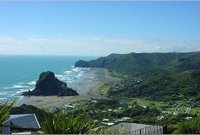 New Zealand is very proud of its interest in conservation. There is actually advertising that New Zealand is a 'nuclear free zone' as well as a highly protected environment. The Department of Conservation has information about National Parks, endemic species, wildlife, nature trails and a number of other environmental areas of interest. There are a network of groups that work to keep and restore the native habitats of New Zealand.
New Zealand is very proud of its interest in conservation. There is actually advertising that New Zealand is a 'nuclear free zone' as well as a highly protected environment. The Department of Conservation has information about National Parks, endemic species, wildlife, nature trails and a number of other environmental areas of interest. There are a network of groups that work to keep and restore the native habitats of New Zealand.
Even kids can get involved. Take a look at Kiwi Conservation Club. Choose one of the Quizzes, then read the linked fact sheet and take the quiz.
New Zealand is one of the most beautiful and contrasting countries on the plant. No wonder they want to conserve it.
Geography Lesson
 New Zealand is unique in geography. With two large islands and several smaller ones, the country offers a lot of contrasts in land forms. There are mountains (the highest in the southern alps), mudpools, geysers, hotsprings, volcanoes, fertile plains, white sandy beaches, black sandy beaches (with high iron content from volcanic ash), glaciers and sunken mountains.
New Zealand is unique in geography. With two large islands and several smaller ones, the country offers a lot of contrasts in land forms. There are mountains (the highest in the southern alps), mudpools, geysers, hotsprings, volcanoes, fertile plains, white sandy beaches, black sandy beaches (with high iron content from volcanic ash), glaciers and sunken mountains.
Forests of sub tropical trees are native to the north island. Plant life of New Zealand is very unique, with many of the plants being endemic. Streams run through the region, some of them are warm as a result of the geothermal conditions of the North Island.
New Zealand sits on two tectonic plates, the Australian and the Pacific. This has caused a number of interesting things in the country; high mountain ridges formed down the center of the two islands and formed high mountain peaks.
Find out more about the geography of New Zealand by reading the geography lesson (and read all the way to the bottom) then go to the Quiz Page and take the Quiz. Write your answers on a piece of paper and turn in to your teacher. At the bottom of the page, write the definition of endemic (so I know you looked it up).
Ethnic People
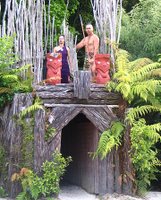 New Zealand's original inhabitants were Māori. Their population once reached 20,000 people. Te reo Maori, the official language of the Māori, is spoken everywhere the Māori people live.
New Zealand's original inhabitants were Māori. Their population once reached 20,000 people. Te reo Maori, the official language of the Māori, is spoken everywhere the Māori people live.
Once a warring tribe of Polynesian decent, the Māori have since assimilated into modern society. Many of the Māori villages have been recreated, in order to teach accurately about their traditions and culture. These villages are mainly tourist atttractions but give glimpse into the past for the curious.
 Rotorua is a village on the north Island. The picture above is of the entrance to the Maori village. Totems top the entrance and seen throughout the village, now valued as aboriginal art of New Zealand. Each tribe had their own special way of making totems.
Rotorua is a village on the north Island. The picture above is of the entrance to the Maori village. Totems top the entrance and seen throughout the village, now valued as aboriginal art of New Zealand. Each tribe had their own special way of making totems.
Today only about 10 percent of the population are Māori. Other people groups are Polynesian and Asian.
Buildings to Behold
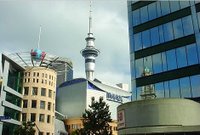 In the very center of the city there is a tall needle shaped building. This is Sky Tower, the tallest building in the Southern Hemisphere.
In the very center of the city there is a tall needle shaped building. This is Sky Tower, the tallest building in the Southern Hemisphere.
The tower is home to a casino, restautrants and even a convention center. There is also the tourist attraction of bungie jumping. I tried to talk my friend into bungie jumping off the top of it, but she didn't much like the idea.
Locals in Auckland don't like this building much, they say it is an 'eyesore' - meaning that they think it is unattractive. They mainly don't like it because someone got the idea that if they built it, New Zealand could have the tallest building in the Southern Hemisphere. But New Zealanders aren't all that interested in impressing the world.
 Many other modern buildings line the Auckland streets; notice in the picture Planet Hollywood just to the left of Sky Tower.
Many other modern buildings line the Auckland streets; notice in the picture Planet Hollywood just to the left of Sky Tower.
There is also a good share of old buildings. Notice the reflection in the large building - that is the Town Hall, built in 1911, at the upper end of Queen Street. Town Hall still a busy place, hosting events all year.
City of Sails
 The next day we decided to skip the conference and see a little of Auckland. We visited a couple of universities in the city center, then just browsed the streets.
The next day we decided to skip the conference and see a little of Auckland. We visited a couple of universities in the city center, then just browsed the streets.
The city of Auckland is home to 451,000 people. If you count the surrounding areas the amount totals 1.2 million. This is one third the population of the entire country.
The city is clean and modern. Known as the 'City of Sails' because of a great number of yachts that sail in the harbours, Auckland sits between two harbors, surrounded by extinct volcanoes.
Touring the Campus
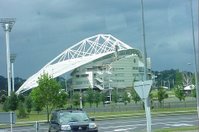 Massey University has very modern facilities. The conference center was so impressive we wanted to see more of the campus. After our first presentation we changed into some sloppy clothes and jumped on the bus.
Massey University has very modern facilities. The conference center was so impressive we wanted to see more of the campus. After our first presentation we changed into some sloppy clothes and jumped on the bus.
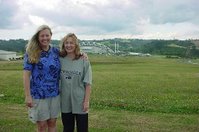 Our driver was great - he stopped at various spots and told us about them, and even offered to take our picture. He was not a tour bus driver, just a regular city bus driver willing to show off the area to a couple of American tourists.
Our driver was great - he stopped at various spots and told us about them, and even offered to take our picture. He was not a tour bus driver, just a regular city bus driver willing to show off the area to a couple of American tourists.
I am quite sure such a thing would not happen in the U.S. - schedules dictate all things in our part of the world.
Showing our Stuff
 Although I am enjoying the scenery in New Zealand, it was not my primary purpose for coming. I have come here to participate in an educational conference. I have worked with a colleague on a paper regarding distance education and we are presenting the results of that paper here. The conference is titled International Conference on Computers in Education (ICCE).
Although I am enjoying the scenery in New Zealand, it was not my primary purpose for coming. I have come here to participate in an educational conference. I have worked with a colleague on a paper regarding distance education and we are presenting the results of that paper here. The conference is titled International Conference on Computers in Education (ICCE).
Our display board included our paper as well as photographs from the program. It wasn't terribly attractive but many people wanted copies of the paper to find out more information. Distance learning is just beginning to be popular, so many institutions are looking to find out what they can from schools that have already made progress in its application.
Tasman Lookout
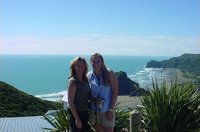 This trail winds up the cliffs at the south end of Te Waha Point. The views of Piha and Whites Beach are lovely, but look a lot like many of the other beaches in this area. It was quite windy today making it not seem so warm. This is only part way up. We are on our way to the Maori museum where we hope to see traditional carvings.
This trail winds up the cliffs at the south end of Te Waha Point. The views of Piha and Whites Beach are lovely, but look a lot like many of the other beaches in this area. It was quite windy today making it not seem so warm. This is only part way up. We are on our way to the Maori museum where we hope to see traditional carvings.
The Caves
 I was fascinated by the caves in the Waitakere Ranges Regional Park. The ones we saw sat high on the sides of the rocky ranges. Our guide told us that during the wars with the British, Maori warriors would hide their families here in an attempt to escape capture. Because of the lush surroundings, the caves are not highly visible, and in the summer time the greenery grows up around the opening, making it even more invisible.
I was fascinated by the caves in the Waitakere Ranges Regional Park. The ones we saw sat high on the sides of the rocky ranges. Our guide told us that during the wars with the British, Maori warriors would hide their families here in an attempt to escape capture. Because of the lush surroundings, the caves are not highly visible, and in the summer time the greenery grows up around the opening, making it even more invisible.
Karekare Falls
 Karekare Falls is located in Waitakere Ranges Regional Park, which stands between the city of Auckland and the Tasman Sea. The terrain here is rugged and diverse, and I was surprised by the height of these falls. Notice the size of my friend in the foreground - that should give you a small indication of how big they are. The pool below was wonderful for wading - and was deeper than it looked.
Karekare Falls is located in Waitakere Ranges Regional Park, which stands between the city of Auckland and the Tasman Sea. The terrain here is rugged and diverse, and I was surprised by the height of these falls. Notice the size of my friend in the foreground - that should give you a small indication of how big they are. The pool below was wonderful for wading - and was deeper than it looked.
Waitakere Ranges Regional Park is only about an hour from Auckland. The hike took us over several types of land; rugged rocks, tropical paths, dense forest and finally ended at the black sand beach.
The Maori Tatoo
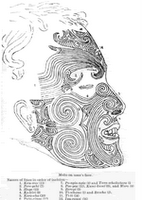 The native people of New Zealand are known as the Maori. There are Maori stories
The native people of New Zealand are known as the Maori. There are Maori stories
about where tatooing originated. These tribal people tatooed their faces with a bone chisel. This is a drawing of the patterns for these tatoos. You can click it for a larger version.
This is the face of Maori Moko, scanned from John Rutherford: The White Chief (pre-1923).


















